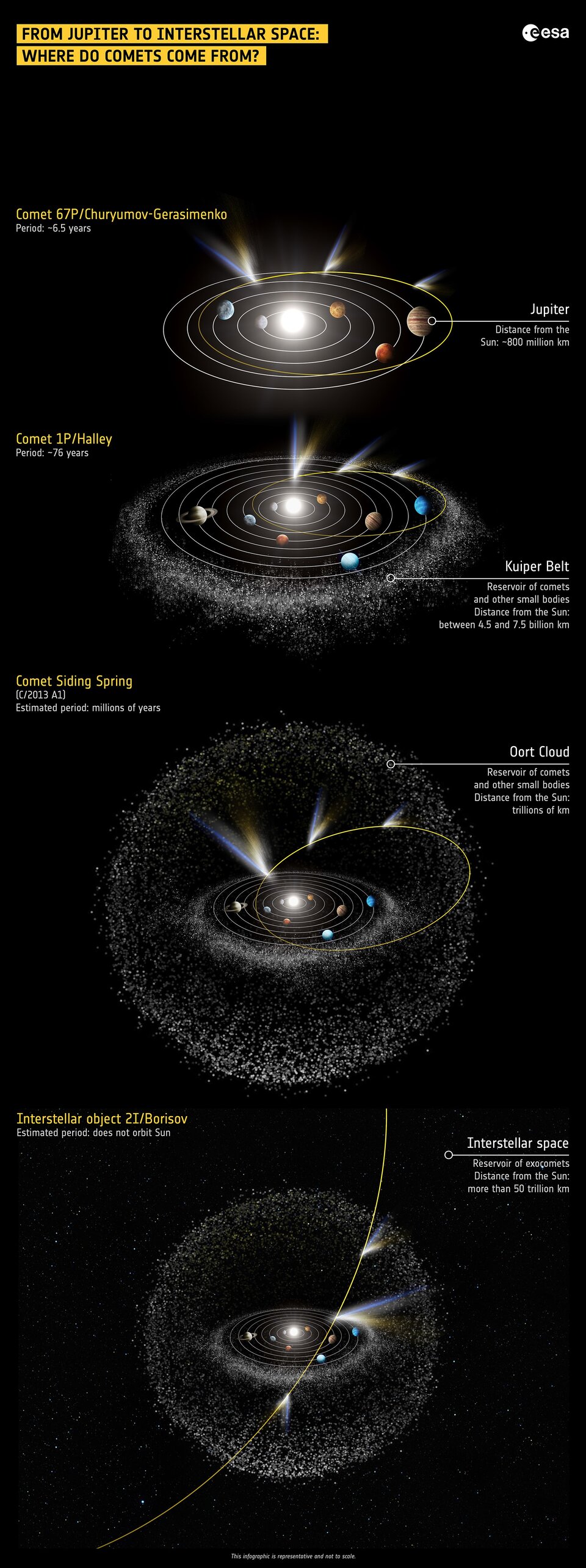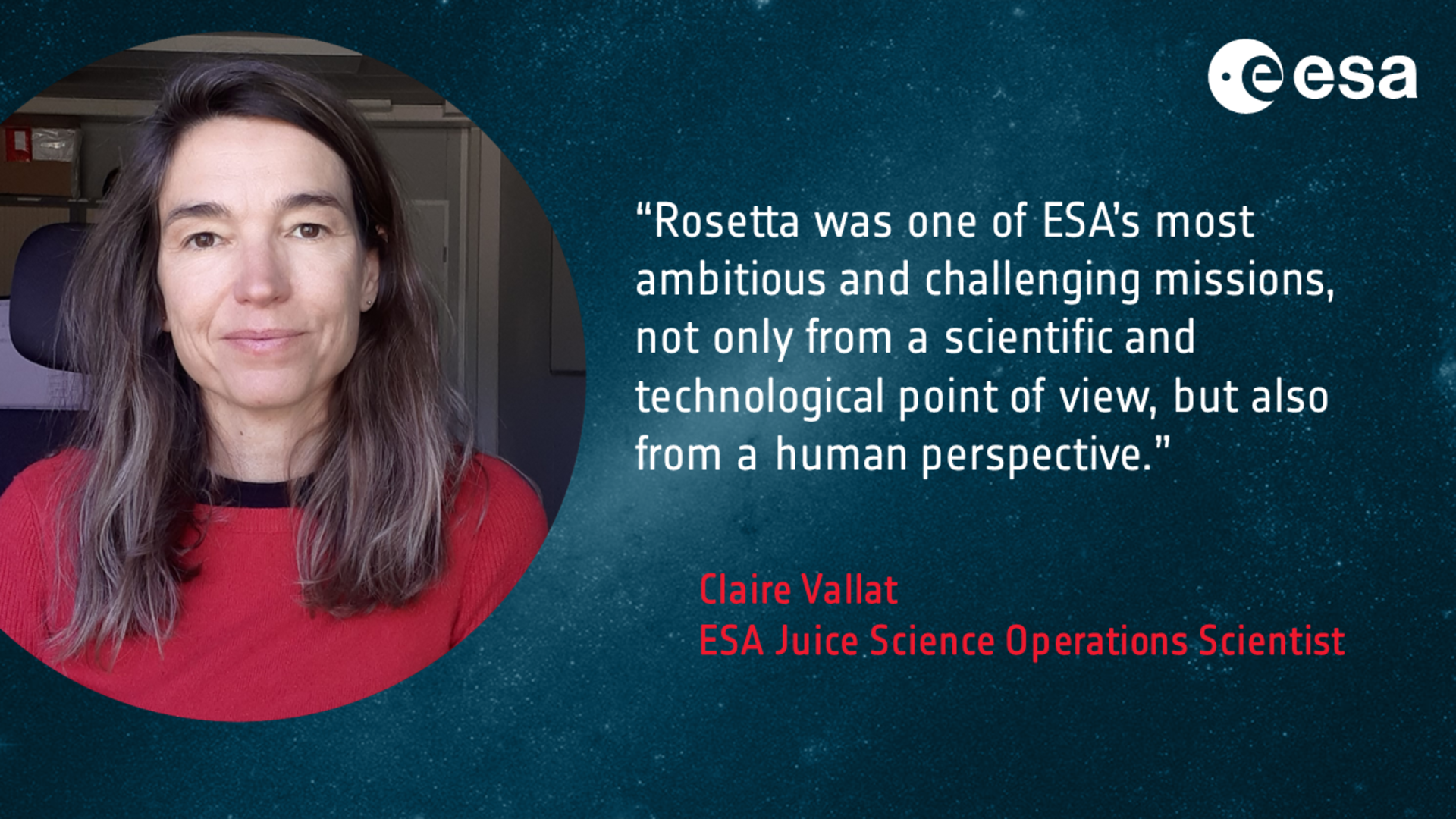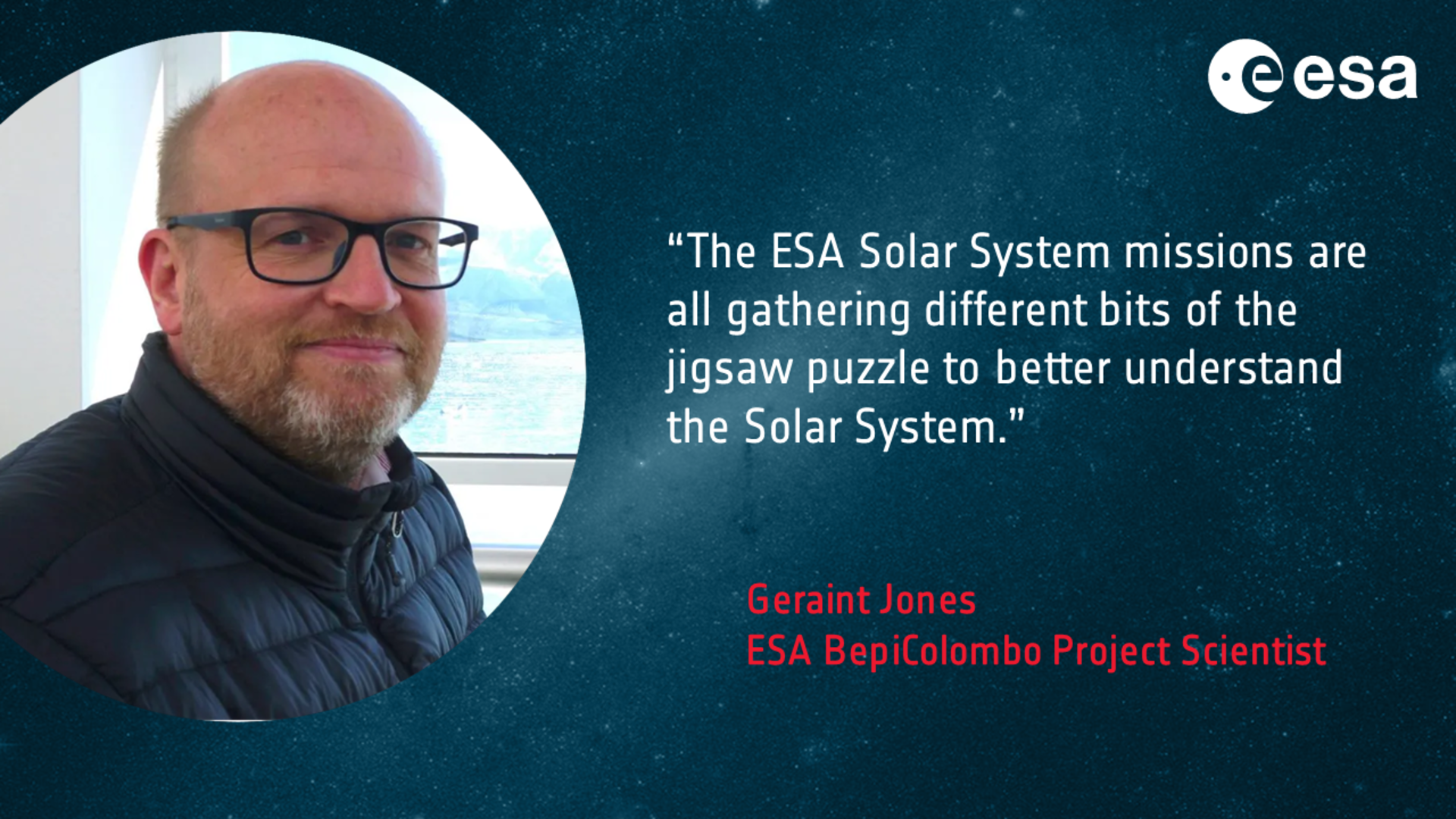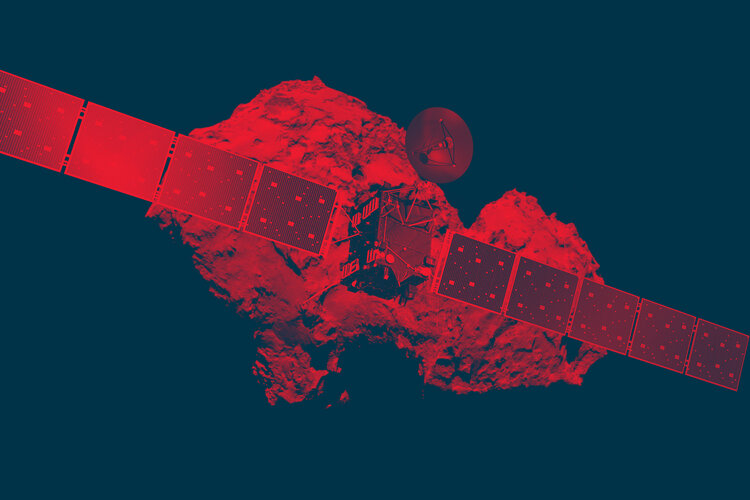Rosetta and beyond: tales of a mission that left a mark
Exactly ten years on since Rosetta arrived at Comet 67P/Churyumov-Gerasimenko, we dig into how the intrepid explorer has transformed our knowledge of comets, revealed some crucial pieces in the Solar System jigsaw puzzle, and shaped how we develop new missions.
Introduction: ESA’s comet chaser
Rosetta arrives at Comet 67P: why does it look like that?
A first glimpse of comet science: after ten years of waiting
Science that sticks: most memorable scientific discoveries
Most detailed study of a comet: reshaping our understanding of the Solar System
Comet Interceptor: ESA’s next-generation comet mission
A fleet of Solar System explorers: Rosetta’s influences on Hera, BepiColombo and Juice
Completing the jigsaw: how ESA missions work together to unveil the Solar System
Rosetta remains one of the world’s most ambitious space exploration missions. It was the first spacecraft to fly alongside a comet as it headed towards the inner Solar System, watching how a frozen comet is transformed by the warmth of the Sun. It was also the first to land on a comet’s surface, with its Philae lander sampling the surroundings of its landing site and snapping close-up images.
In this article, we speak to seven scientists who were part of team Rosetta when it arrived at Comet 67P. All of them have gone on to work in current or future ESA space science missions.
August 2014: Rosetta arrives at Comet 67P
After a ten-year voyage through space, in August 2014 Rosetta finally approaches its target comet. The team is expecting to see that the solid, central part of the comet – its ‘nucleus’ – is shaped like a potato. The images that come down showed something completely different.
Claire Vallat, who was planning the mission science at the time says: “When we received the first detailed image of the nucleus I was on holiday but frenetically checking my phone for any new OSIRIS images whilst we were approaching Comet 67P.” OSIRIS was Rosetta’s camera, which gave us our first view of the comet.

“This was a very exciting moment since the nucleus shape did not look at all like how we envisaged it until then: it had two lobes rather than being potato-shaped! I remember thinking that it would be extremely challenging to land Philae on such a complex object, but very exciting too.”
For Geraint Jones, who went on to propose ESA’s Comet Interceptor mission, the first view of Rosetta’s comet came as a surprise for a different reason: “It was during the summer, I was on holiday and I had no internet access. So I actually saw the shape of the comet for the first time on a newspaper stand in Germany!”
Geraint was amazed to see the incredible level of detail in the images, with intricate landforms and bizarre terrain.
Nick Thomas, who was on Rosetta’s OSIRIS camera team, adds: “What you have to recall is that Rosetta took a while to reach the comet. Data was being taken already when it was still just a distant dot. This is a rather slow process, with the comet getting bigger and bigger. It suddenly became very real when we were able to take a movie of this thing for the first time, and we saw this dual object – that was staggering, it told us we were there, and we were going to find something special.”
The arrival of Rosetta was perfect timing for plasma scientist Charlotte Götz, who started her PhD that same month. Charlotte was one of the first to work with data arriving from the mission. “One thing I remember was that during these first weeks and months, people were super excited – some people had waited for this data for 30 years, since Giotto!” says Charlotte. Launched in 1985, Giotto was ESA’s first and only previous comet mission.
A first glimpse of comet science

It takes a long time to develop a space mission and get it to its final destination: 20 years passed between the first design of Rosetta and seeing the first science results. Understandably, the scientists were eager to get their hands on the data.
“I have to say that I’m a data junky,” admits Nick. “I get a real kick out of being the first person to see data coming down from a spacecraft – that’s why I do this job.”
For all the scientists involved, receiving the first data and seeing that a spacecraft’s instruments are working as planned is equal parts thrill and relief. But it doesn’t always come that easy.
Johannes Benkhoff had been working on two of Rosetta’s 21 science instruments: VIRTIS and MUPUS:
“VIRTIS was working very nicely and as expected, but unfortunately since the Philae lander didn’t land as we had hoped, the operation of MUPUS was different to what we expected; it should have dug straight down into the comet’s surface, but instead it went sideways. We did still get some data, but it was a little bit disappointing.”

“As a scientist, you work on something for years, and then you finally get to harvest,” he adds. “Sometimes you get your reward very late, and sometimes not at all.”
Nick gives an impression of just how much work goes into preparing an instrument, long before the data reward arrives: “There are upwards of 120 people working on these systems, it’s a full team effort. For example, during the instrument calibration in 2001–2002 I worked nights for about four months, figuring out issues at night so that engineers could fix them during the day. Seeing that an instrument functions correctly and produces valid scientific data is absolutely necessary and an important part of the scientist’s work.”
Science that sticks
These first glimpses of science were just a teaser of what was to come. Rosetta changed our view of how the Solar System formed, how the planets were made, and how life began. What scientific discoveries stick in the mind of our team?
“There were so many science results that it’s hard to pick one!” says Claire. A few seconds later, she adds: “The shape of the nucleus was a real surprise, and it raised the question of whether this was the result of specific erosion processes or of a collision between two distinct bodies. Analysis of data from multiple instruments confirmed the latter, and provided key information on the formation of the Solar System.”
Nick gives two examples: “One thing that we were not expecting was just how important dust particles falling back onto the nucleus is. This was described in the nineties as a ‘dust hail’ but at the time nobody appreciated just how important it really is, how much material falls back onto the nucleus and makes this dust covering, which reduces the activity of the comet.”
“The other thing that was really shocking in those first images was how diverse the nucleus surface is,” he adds. “There are places that you would expect to have been affected by the same heat and radiation from the Sun, but the surface texture is totally different.”

Michael Küppers, who worked with Claire on Rosetta mission science and is now Project Scientist for ESA’s Hera and Comet Interceptor missions, also finds it hard to settle on one scientific discovery.
“Rosetta revealed the importance of the transport of material from the illuminated side of the nucleus to the dark side, which partly shapes the surface of the nucleus. But it also found lots of organic material, saw cliffs collapsing, and provided data that suggests that some noble gases in Earth’s atmosphere actually come from comets.”
Zooming out from the nucleus, Geraint explains that he found the discoveries on the interaction between Comet 67P and the solar wind fascinating: “The comet releases gas into fast plasma coming from the Sun. It’s like throwing paint into a stream and the paint mixes with the water. Rosetta sitting in this flow was a very important part of the mission, it informed our understanding of how comet plasma tails form.”

Charlotte also works on plasma, a charged state of matter that makes up 99.9% of the visible Universe, including the Sun and other stars. Looking through the Rosetta data, she found that a powerful outburst from Comet 67P had pushed away the solar wind, creating a region of zero magnetic field:
“We knew this happened at comets thanks to Giotto – but with Rosetta we were quite far away from the nucleus and we didn’t think we would be close enough to see it – it actually became the focus of my PhD to analyse the Rosetta data and find out why this ‘cavity’ was so much bigger than expected.”
Most detailed study of a comet
The Rosetta mission officially ended in 2016, but the scientific discoveries keep coming. It was only after the mission, once the hectic work of actually operating the spacecraft was over, that scientists could focus on digging deeper into the data.
Charlotte explains why so many people are still working on Rosetta data: “This mission is so unique, and the instruments are so unique in their properties and how they react to the environment; for years after mission end, our team spent a lot of time figuring out how to treat the data and improve it.”
During the active mission phase, scientists focused on publishing science based on data collected by individual instruments. But since then, there’s been time to focus on making it easier to combine and compare datasets from different instruments, allowing them to delve even further into comet science.
Charlotte gives an example: “There was a recent paper about ultraviolet auroras at Comet 67P, this was the first time that auroras were detected at a comet. The discovery needed to combine data from multiple instruments, which was only possible once the data had been calibrated and understood. This leads to discoveries that are not immediately obvious!”
“For me the post-mission phase never ends, we’re always trying to improve things and the really exciting science happens in the years after,” Charlotte adds. “There’s still so much data that we haven’t really looked at – the instrument I worked on produced 20 measurements each second, for example, so I’m sure there will be something that we still find.”
Remaining mysteries include how changes in the plasma near a comet’s nucleus affect its distant tail, and the relationship between the ice-dust material that makes up the surface and the gas just above the surface.
Comet Interceptor: ESA’s next-generation comet mission
Whilst scientists are still wading through data from Rosetta, ESA is planning its next mission to visit a comet – Comet Interceptor.
Michael leads on its scientific goals: “Comet Interceptor is perceived on a completely different philosophy. The real star of the mission is the target – we are aiming for a new comet coming into the inner Solar System for the first time.”

Broadly speaking, there are two main types of comets. Short-period comets, like those visited by Rosetta and Giotto, whizz around the Sun in less than 200 years; every time they pass close to the Sun, they are transformed by the Sun’s heat and radiation. Long-period comets, on the other hand, have visited the inner Solar System only very rarely, in some cases never.
Geraint tells us more about Comet Interceptor’s science ambitions: “The overall aims of Comet Interceptor are to see the surface of a comet before it’s sculpted by the heat of the Sun and before the most exotic ices have turned to gas. We want to go to a different type of comet – a really, really pristine comet, that’s a real time capsule from when the Solar System was formed.”
Michael points out: “By visiting an unchanged – or ‘dynamically new’ – comet, Comet Interceptor will help us determine which of the larger features seen by Rosetta are original, and which were formed as the comet passed around the Sun.”
“If we get really good resolution images of the nucleus of a dynamically new comet, we can compare the images of the two and ask ourselves how they look different,” adds Nick. “A significant fraction of the science comes in that moment, the first result in 30 seconds.”
One thing that scientists will be looking into is whether the surface of Comet Interceptor’s comet looks different to the short-period ones we have encountered before. Will it also be as dark as coal, and if not, can we tell why not?
What’s more, Rosetta has taught us valuable lessons that those working on Comet Interceptor are using to plan the mission.
Charlotte is ready with an example: “We realised with Rosetta that one spacecraft is not enough to study plasma around a comet, we need measurements from multiple angles and so we designed Comet Interceptor to consist of three spacecraft.”

By making measurements from three different locations in space, scientists will be able to build a 3D map of the magnetic field around a comet, making a huge difference to our understanding of how the solar wind interacts with a comet.
Nick adds: “One thing that’s really important to mention is that so many good young people working on Rosetta moved on to become more senior people in Comet Interceptor. Others have gone off to do something else, and they do it well because they were inspired by Rosetta, they saw what an impact one can make to these missions.”
A fleet of Solar System explorers
Comets are only one type of object in a Solar System full of planets, dwarf planets, moons and asteroids (see comets vs. asteroids). Rosetta’s significant impact on ESA missions heading to these other objects may come as a bigger surprise.
Hera, due to launch in October 2024, is the first planetary defence mission developed under ESA's Space Safety Programme. Hera will visit a double asteroid as part of the world’s first ever asteroid deflection experiment. Hera will carry two smaller satellites; one with a radar instrument based on Rosetta’s CONCERT, and the other with a dust measuring instrument based on Rosetta’s GIADA.
Hera Project Scientist Michael Küppers explains how else the mission has benefitted from Rosetta: “Hera builds upon Rosetta operations, with the orbit scheme borrowed directly from the comet mission. Though Hera has more autonomy, the navigation scheme in the early phases is the same as Rosetta’s.”

ESA’s Mercury mission BepiColombo also benefits from lessons learned from Rosetta, with aerospace manufacturer Astrium (later merged to form Airbus Defence and Space) building both missions. Like Hera, some of BepiColombo’s instruments are similar to Rosetta’s.
“There are entire teams that worked on Rosetta now working on BepiColombo,” explains BepiColombo co-Project Scientist Johannes. “For example, many involved in Rosetta’s VIRTIS imaging spectrometer instrument are now working on BepiColombo’s similar SIMBIO-SYS, and the magnetometer teams are similar on both missions. The planetary science community is quite small!”
Claire tells us about how Rosetta has helped prepare ESA for its Jupiter Icy Moons Explorer (Juice) mission, currently on its way to Jupiter.
“Rosetta is one of the most ambitious and challenging missions, also from a human perspective. It was a long project involving people spread all over the world, sometimes belonging to different generations, all learning to work together towards a common scientific goal. This was really inspiring and very good preparation for Juice, which will, like Rosetta, have a long cruise phase and will require similar interactions and preparation.”
Completing the jigsaw
Each of our Solar System explorers has different goals and carries different instruments. They ask different questions and give different answers. But ultimately, they each provide a piece of the puzzle in revealing the Solar System.
“Rosetta, Comet Interceptor and Hera are all missions to small bodies, which are kind of the leftovers of the formation of the Solar System. These bodies have not changed much since the Solar System formed,” says Michael. “Other missions investigate planets – the outcome of the formation process. They’re at the other end of the scale, seeing the most processed parts of the Solar System. Putting all of this together, we better understand how the Solar System formed and evolved.”
Johannes adds: “If you look at a comet, you get some information from far out of the Solar System. Then looking at Mercury, you see the planet closest to the Sun. So with both a comet and Mercury, we have the two ends of the spectrum – closest to and furthest from the Sun.”
“It’s important to study the extreme cases in order to understand the physics and what’s going on – it’s not enough to look only to Mercury, not enough to look only at comets – we need both to get the bigger picture.”
Patrick Martin has worked on two of ESA’s Mars missions since being Rosetta Mission Manager – Mars Express and ExoMars Trace Gas Orbiter (TGO). “These three missions contribute to the study of our Solar System as a whole, maintaining ESA’s presence and leadership in space science. Rosetta was a pioneering cometary science mission following in the footsteps of Giotto, while Mars Express and ExoMars TGO enable and foster ESA’s presence at Mars as part of the robotic exploration of the planet, before crewed flights become a reality.”
Timeline
2 March 2004 – Rosetta launch
20 January 2014 – Rosetta wakes up
6 August 2014 – Rosetta arrives at Comet 67P
12 November 2014 – Rosetta’s Philae lander lands on Comet 67P
30 September 2016 – Rosetta mission complete
19 June 2019 – Comet Interceptor selected as ESA mission
8 June 2022 – Comet Interceptor approved for construction















